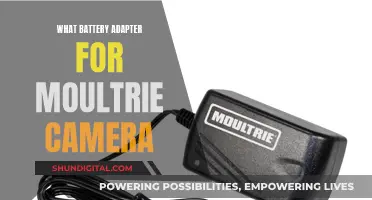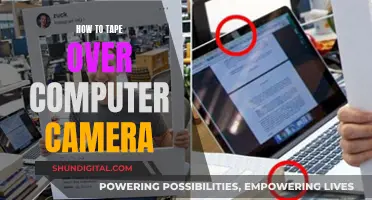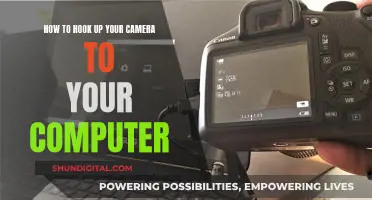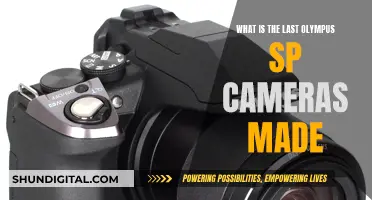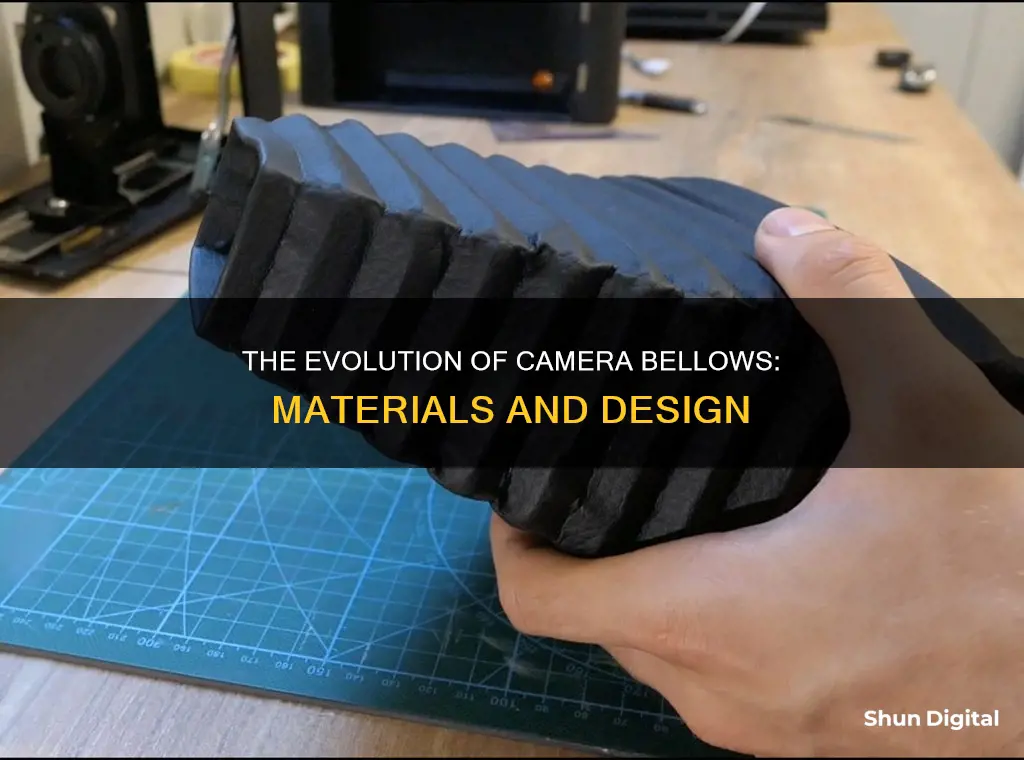
Camera bellows are the accordion-like, pleated expandable part of a camera, usually a large or medium format camera, to allow the lens to be moved with respect to the focal plane for focusing. The bellows provide a flexible, dark extension between the film plane and the lens. Bellows are typically made of lightweight, thin materials such as leather, cloth, paper, vinyl, plastic, or synthetic fabric. The choice of material depends on factors such as cost, ease of folding, and light-tightness. Some materials may be treated or coated to enhance their properties, such as by vulcanizing or polyurethane-coating nylon to make it lightproof.
| Characteristics | Values |
|---|---|
| Purpose | Allow the lens to be moved with respect to the focal plane for focusing |
| Use | Provide a flexible, dark extension between the film plane and the lens |
| Types | Bag bellows, accordion bellows |
| Material | Lightweight close-weave material, thin leather, synthetic black leather, thin synthetic material, thin paper, thin cloth, thin vinyl, thin plastic, thin rubberized black cloth, thin black fabric, thin faux suede, thin polyurethane |
| Structure | Sandwich of light-proof liner and protective covering with thin fiber stiffener strips in between |
| Shape | Accordion-like, pleated |
What You'll Learn
- Camera bellows are made of thin, flexible materials like leather, cloth, vinyl, or paper
- The outer layer of the bellows may be light-proof, but it is not necessary if the inner layer is light-tight
- Bellows can be made at home with the right materials and measurements
- Synthetic materials were used for camera bellows in the mid-20th century, replacing leather
- Bellows can be replaced or repaired if damaged, ensuring longevity for vintage cameras

Camera bellows are made of thin, flexible materials like leather, cloth, vinyl, or paper
Camera bellows are typically made from thin, flexible materials such as leather, cloth, vinyl, or paper. The bellows are the accordion-like, pleated expandable part of a camera, usually a large or medium format camera, that allows the lens to move with respect to the focal plane for focusing. They provide a flexible, dark extension between the film plane and the lens.
The choice of material for camera bellows depends on factors such as cost, durability, and light-tightness. Synthetic black leather, for example, is light-tight and thin enough for folding, making it a suitable option. Some photographers opt for cheaper alternatives such as blackout curtain material or vinyl surface covering. In the past, natural materials like leather were more commonly used, but synthetic materials became more prevalent in the mid-20th century.
When creating camera bellows, it is important to consider the thickness of the material. The bellows need to be able to fold and collapse into a compact size for portability. Thicker materials may not fold as easily or allow the camera to shrink to a small enough size for storage or transportation.
Additionally, ensuring light-tightness is crucial for the functionality of the bellows. Materials like leather or specially treated fabrics are often chosen to prevent light leaks that could affect the quality of photographs.
Making camera bellows involves carefully measuring and cutting the chosen materials, including the liner, covering, and stiffener strips. The process requires precision and patience, especially when gluing the different layers together and forming the folds.
In summary, camera bellows are constructed from thin, flexible materials like leather, cloth, vinyl, or paper, with a focus on durability, light-tightness, and ease of folding for portability. The process of making camera bellows involves careful measurements, the selection of suitable materials, and the assembly of layers to create a functional and compact component of the camera.
Polaroid Cameras: UK-Made Models' Value Explored
You may want to see also

The outer layer of the bellows may be light-proof, but it is not necessary if the inner layer is light-tight
Camera bellows are the accordion-like, pleated expandable part of a camera that allows the lens to be moved with respect to the focal plane for focusing. The bellows provide a flexible, dark extension between the film plane and the lens. The outer layer of the bellows may be made of thin leather, cloth, vinyl, paper, or synthetic material, and it can be light-proof. However, it is not necessary for the outer layer to be light-tight if the inner layer is light-tight.
The inner layer of the bellows is typically made of a light-proof liner of rubberized black cloth or similar material. This layer ensures that no light leaks into the camera through the bellows, which could affect the exposure and quality of the photograph.
When constructing camera bellows, it is important to use very thin materials so that the bellows can easily fold up inside the camera. The total thickness of the liner, stiffener strips, glue, and outer covering should be around 0.024" (0.625mm) or less. This allows the bellows to collapse and expand smoothly and fit within the camera when closed.
While the outer layer of the bellows may be light-proof, it is not a requirement as long as the inner layer is light-tight. This means that the outer layer can be made of a wider range of materials, some of which may be more durable, easier to work with, or cheaper than light-proof alternatives.
In summary, the outer layer of camera bellows may be light-proof, but it is not necessary if the inner layer is designed to prevent light leaks. This provides some flexibility in the choice of materials for the outer layer, as long as the inner layer maintains the critical light-tight property required for proper camera function.
How Cameras Precede Photos: A Historical Perspective
You may want to see also

Bellows can be made at home with the right materials and measurements
Bellows: Can Be Made at Home with the Right Materials and Measurements
Bellows are a crucial component of folding cameras, allowing them to collapse into a compact size for easy portability. While it may seem daunting, making your own camera bellows is achievable with careful measurements, the right materials, and step-by-step guidance. Here's a comprehensive guide to crafting camera bellows in the comfort of your home.
Planning and Materials
Before embarking on the construction process, it's essential to have a clear understanding of the desired features and functions of your camera. Consider factors such as the required range of motion, exceptional bellow draw, and the desired professional appearance. Having a well-defined plan will make the building process more manageable.
Now, let's gather the necessary materials:
- Sketching tools (ruler, pencil)
- Synthetic black thin leather or light-tight fabric for the exterior
- Thin, inexpensive black fabric for the interior
- Thick paper (around 200g) for panels
- Spray glue or contact cement
- Scissors or a sharp knife
- Masking tape
- Cardboard or thin wood for creating a form (optional)
Step-by-Step Guide
- Create a Design: Start by carefully examining the old bellows you plan to replace or use online resources and tutorials to design your bellows. Trace the outline, paying close attention to angles and lengths, and measure the width of each panel. Transfer your measurements to a piece of paper and sketch the design for all four sides of the bellows.
- Prepare the Panels: Glue your design onto a thicker piece of paper, such as thin plastic or thick paper (200g). This will provide the necessary structure for your bellows.
- Cutting and Assembly: This step involves a lot of cutting, so take your time. Cut out the fabric for the exterior, leaving a little extra (around 1.5 cm) on the edges. Then, copy the exterior piece for the interior fabric. Position and glue the panels together, marking the centres to maintain alignment.
- Bonding the Fabric: Apply glue to the interior fabric and attach it to the panels. Leave one corner panel half-glued to ensure a tight seal.
- Closing the Bellows: Apply glue to the edge of the exterior fabric and press it firmly onto the panels to close them up, ensuring the fabric overlaps to prevent light leakage. Allow the bellows to dry overnight.
- Folding Practice: The next day, start practising folding the bellows. It might seem challenging at first, but with practice, it will become easier. Leave the bellows folded for a few days to help the fabric retain its shape.
- Final Assembly: Install the new bellows by attaching them to the front frame of your camera. Insert the bellows from the back and work the last fold into position, ensuring it is square to the frame and camera body.
- Testing: Test your newly installed bellows for light leaks and ensure they do not interfere with the image area by laying a ruler along the edge of the rear lens.
Tips and Tricks
- Finding the Right Fabric: The exterior fabric should be light-tight and thin enough for folding. Synthetic black leather or light-tight fabric, such as vulcanized or polyurethane-coated nylon, are good options. For the interior, a thin, inexpensive black fabric will suffice.
- Accurate Measurements: Take precise measurements of the length, width, and height of the bellows material, as well as the width and number of stiffeners. This will ensure your replacement bellows fit perfectly.
- Practice Makes Perfect: Don't be discouraged if your first attempts at folding the bellows don't go as smoothly as expected. It takes practice to master the technique, but with patience, you'll get the hang of it.
- Temporary Fixes: If you discover light leaks in your old bellows, you can temporarily patch them with light-tight materials like black RTV silicon gasket sealer or light-proof cloth. However, keep in mind that this is not a long-term solution, and replacing the bellows is recommended.
By following these detailed instructions and gathering the necessary materials, you can successfully create camera bellows in the comfort of your home. Remember to take precise measurements, choose the right fabrics, and be patient during the folding process. With dedication and attention to detail, you'll be on your way to crafting functional and aesthetically pleasing camera bellows.
Analog Cameras: Still Relevant, Still Made?
You may want to see also

Synthetic materials were used for camera bellows in the mid-20th century, replacing leather
Camera bellows are the accordion-like, pleated expandable part of a camera, usually a large or medium format camera, to allow the lens to be moved with respect to the focal plane for focusing. The bellows provide a flexible, dark extension between the film plane and the lens.
In the early days of camera development, the bellows were commonly made of leather. Leather bellows could be remarkably long-lasting—some over a hundred years old are still soft and lightproof. However, leather bellows were susceptible to disintegration if poorly stored or treated, and they would stiffen if allowed to get wet.
In the mid-20th century, synthetic materials began to replace leather as the standard material for camera bellows. This shift may have been influenced by the increasing use of synthetic materials in various industries during this period. Synthetic leatherette, vinyl, polyurethane-coated nylon, and silicone-coated paper emerged as alternative materials for camera bellows. These synthetic materials offered advantages such as durability, flexibility, and light-tight properties.
Today, camera bellows are typically made of synthetic materials, ensuring light-tightness and durability while allowing for the necessary flexibility and movement. The use of synthetic materials has contributed to the continued popularity of bellows cameras, with new models still being created for studio photography.
Creative Warm Contrast: Camera Raw's Cozy Effect
You may want to see also

Bellows can be replaced or repaired if damaged, ensuring longevity for vintage cameras
Camera bellows are made of flexible, light-tight materials, such as thin leather, cloth, vinyl, paper, or synthetic fabric. Over time, they can become damaged, with pinholes and cracks forming, especially in the corners and along the edges where the bellows fold. This can cause light leaks that fog the film and ruin photos. However, it is possible to repair or replace the bellows to ensure the longevity of vintage cameras.
For temporary repairs, photographers often use black electrical tape to cover pinholes and cracks. A more permanent solution involves using a small batch of bellows blacking, made from a mixture of glue, liquid dish detergent, and lamp black, which is brushed onto the affected areas. For larger pinholes, thicker paints, such as Liquitex Mars Black Acrylic, can be used. In some cases, a black silicone rubber product may be applied by inserting a pin into the pinhole and using it to draw the silicone into the hole before sealing it from the outside.
For larger rips in the bellows, a patch kit can be used, or the bellows can be replaced entirely. This typically involves carefully measuring the length, width, and height of the material, as well as the width and number of stiffeners, to create a new bellows that matches the original design. The process requires precision and the right materials, but it is possible to make or purchase replacement bellows to restore the functionality of vintage cameras.
In summary, camera bellows can be repaired or replaced if damaged. Temporary fixes include using black electrical tape or fabric paint to cover pinholes. More permanent solutions involve using bellows blacking or thicker paints to seal larger pinholes. For serious damage, replacement bellows can be purchased or custom-made, ensuring that vintage cameras can continue to be used and enjoyed for years to come.
Waterproof Camera Secrets: How Are They Made?
You may want to see also
Frequently asked questions
Camera bellows are made of a thin, flexible, dark, and light-tight material. The outer covering is usually made of thin leather, cloth, vinyl, paper, or synthetic fabric, while the inner lining is typically a light-proof liner made of rubberized black cloth or similar material.
Camera bellows allow the lens to move with respect to the focal plane for focusing, providing flexibility and enabling photographers to correct distortion and avoid converging or diverging verticals in their photographs.
Camera bellows are commonly found in large and medium format cameras, as well as in some folding cameras and enlargers. They were especially popular in the first half of the 20th century for amateur photography due to their compact size and ease of use.
Over time, camera bellows may develop light leaks, tears, or become stiff and fragile. If you notice any holes or significant wear and tear, it is recommended to replace the bellows to ensure optimal camera performance and maintain the collectible value of vintage cameras.
You can source materials for camera bellows from camera stores, fabric stores, online retailers, or camera repair shops. Some specific sources mentioned include Porters camera store, Custom Bellows UK, and local fabric stores for blackout curtain material or vulcanized nylon.



